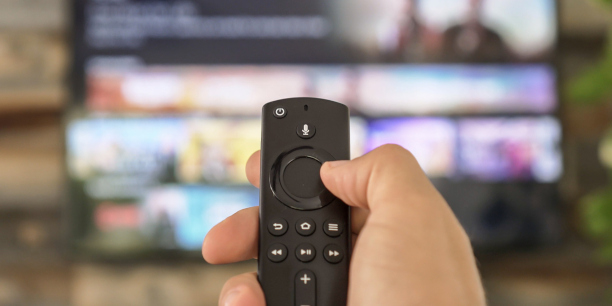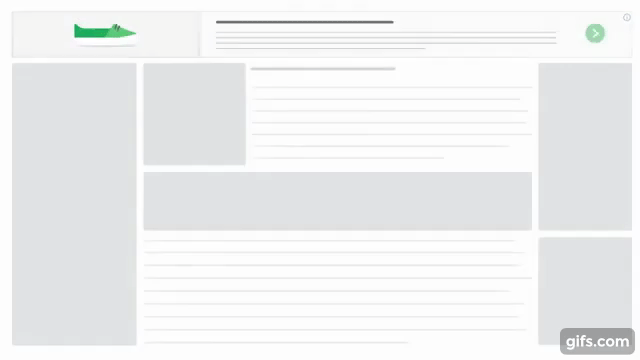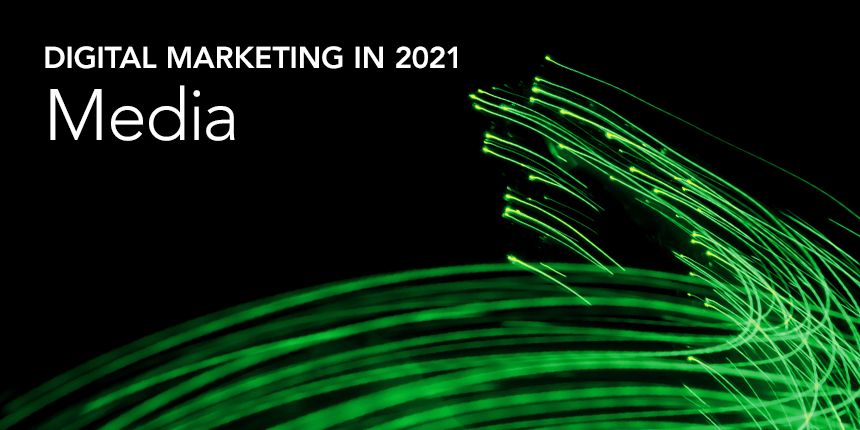We’re focusing on paid media in the second part of our 2021 predictions series. This time, we gaze into our crystal ball to double down on a previous prediction, envision a world without (third-party) cookies, and explain why huge advancements in bid automation still require humans at the controls.
-
Digital TV and video rise in importance following pandemic bump
Last year we called out digital video as a key influencer of purchase behaviour as it showed increased engagement and consumption year on year. We also predicted a new era in TV advertising with the rise in non-linear digital TV. We did not predict a global pandemic-sized momentum shift in digital video and TV in 2020.
Widespread quarantines led to a 20% year-on-year increase in the amount of time people spend with digital video and streaming services versus 10% growth in previous years. Traditional TV buys were disrupted with many companies slashing or pausing their marketing budgets as they tried to navigate through the health and economic crisis. In June, eMarketer’s 2020 US linear TV ad spending estimate was down from about $71.18 billion to $60.00 billion. Though advertiser investment in digital video is also slated to decline by the end of 2020, it won’t fall at the same rate as linear TV.

Digital TV and video have started to fill a gap in the market as a more agile, flexible, measured, and targeted way for advertisers to reach audiences at scale. Globally, users have increased YouTube time spent and changed where and how they consume it—27% of YouTube viewing now happens via Connected TV (CTV) devices, up from 16% in 2019. By the end of 2020, CTV ad spending is forecast to increase by 27.1% year over year. If you haven’t started adopting digital video as part of your media mix, the time is now.
What can you do to leverage the surge in digital video effectively?
- Keep the main goal in mind with creative: driving users to your site and tracking that visit. When running digital video on CTV platforms, YouTube, Facebook etc., the goal is to drive a site visit which can be attributed to your campaigns. Creating 0:15 or 0:30 second assets with a main CTA of “visit our website” keeps users in more of a measurable closed-loop bubble.
- Tailor video content to the specific channel, but if a one-size-fits-all approach is the only option, don’t let that stop you. About 36% of advertisers shy away from running video campaigns due to creative development constraints. While each digital video channel from CTV to social has nuance, creating a single asset that fits requirements across platforms can run in multiple places creating a “campaigning” effect.
- Get in market early with Connected TV. Second only to linear TV—a $70 billion market in the US—advertising in premium OTT content via CTVs is rapidly growing to become an $8 billion slice of the overall pie. It’s forecast to double in size by 2024. Subscription OTT and CTV, unlike linear TV, are performing well in both growth and engagement metrics, gaining new users at a fast clip and showing substantial increases in activity among current users.
- Map digital KPIs to digital video. There’s no reason not to use the same measuring stick to assess digital TV and video alongside other upper funnel digital marketing efforts. While the industry searches for standardised measurement, optimise your campaigns to first-party on-site user behaviour. Take a direct response approach to TV and video with measurable results.
-
Cookies: The party is almost over (well, for third-party)
Cookies and digital advertising go way back. For about 25 years marketers have relied on third-party tracking cookies to track and target specific consumer behaviour online. Earlier this year we wrote about digital advertising in a cookie-less future. Since the guillotine will drop once Chrome starts cookie blocking, it makes the cut for our 2021 predictions. As the internet’s most dominant browser at 60% market share, a shift in Chrome could be the nail in the coffin for third-party cookies. It’s expected to happen somewhere between 2021 and 2022, while Apple’s Intelligent Tracking Prevention (ITP) and Firefox’s Enhanced Tracking Protection (ETP) already block third-party cookies by default. This is widely becoming a fundamental change to how online advertising is approached.

In response to this, major players Google, Microsoft, and Facebook have been providing advertisers with a first-party cookie option for its advertising tracking pixels. When ITP 2.0 essentially broke Facebook’s pixel code on Safari, they switched pixel tracking defaults to the first-party cookie. The cookie looks like it’s coming from the advertiser site, while in fact it sends data back to Facebook. It’s intended to help businesses continue using analytics and tracking ad attribution, independently of the browser they’re using.
Whether it was via Google Analytics, Global Site Tag implementation, or conversion linker via GTM, anyone running AdWords media would have adopted first-party tracking strategies to prevent Safari conversion drop-off post-ITP 2.0. We anticipate continued burgeoning interest across major players in the ad game in first-party data structuring and integration with ad platforms.
-
What does this mean for major ad platforms and networks where you’re running media?
Facebook and Google fully understand the power of their first-party data. By eliminating the impact of third-party data brokers or third-party data collectors, there will be more emphasis on the one thing they can control: the data they gain from their own users and how that data is activated within their own networks. Major platforms and networks are sitting on treasure troves of data to drive marketing efforts within their walled gardens. Let’s not forget, both Google and Facebook have considerable skin in the game when it comes to digital ad revenue.
-
What does this mean for advertisers?
So far, it seems like Chrome will seek to phase out the third-party cookie on its browsers. However, first-party cookies that track browsing data about your own website’s visitors are still safe. This means that any first-party data you gain from your website’s visitors on all browsers will remain intact. Facebook and Google will continue to allow marketers to use and optimise towards their own first-party data. This type of strategy has been in our blood for years. We emphasise client data-driven advertising within client media mixes while deprioritising those that utilise purchased data from third party vendors/platforms.
Here’s what you should be thinking about in 2021: What is my first-party data strategy? Am I utilising my first-party data to inform digital marketing efforts? Am I doing anything that detracts from the value of my first-party data? Time to heavy up on media efforts that utilise data based on how customers interact with your own digital properties. Rely less on media efforts targeting audiences by way of third-party data.
-
-
Have you heard the word “automation” enough yet?
This year, automation of bid strategies, ad serving, and certain aspects of campaign optimisation became par for the course. Heading in to 2021 it almost feels like a faux pas if you’re not involving automation in some way across digital marketing efforts. When leveraged correctly, automation can drive significant performance growth and it’s on the right side of future-proofing your digital media strategy. Let’s face it, the walled gardens know they can keep generating revenue as advertisers see stronger returns and efficiency in a win/win scenario. When given the right signals, major ad tech platforms now have a hound-like ability to bid higher on the customers that matter in the moments that matter.
Facebook Ads rolled out Campaign Budget Optimisation (CBO) in 2019, which automatically manages your campaign budget across ad sets while you control budget at a campaign level. Campaigns optimise bids based on the combination of Facebook pixel data. This feature became status quo in 2020. We’ve seen novel growth from dynamic and product feed-based tactics in prospecting new customers vs. leveraging existing customers.

The applications of artificial intelligence (AI) within Google Ads platforms are also becoming far more sophisticated. With Responsive Search Ads (RSAs), Google is leveraging AI to drive search ad copy automation across all advertiser accounts. Smart Shopping Campaigns (SSCs) are at the forefront of new ecommerce products at Google which combine standard shopping and display remarketing campaigns while leveraging automated bidding and ad placement. Google Smart Bidding leverages automated “bid strategies” powered by machine learning to drive campaigns towards a CPA, ROAS, or conversion value target.
The migration of major platform functions towards automation is clear. Though this technology is powerful, it still needs a trained pilot at the helm. Especially with the pandemic this year, we’ve seen that the market can shift quickly. Human eyes and hands remain better equipped to pivot when needed. Though this technology is powerful, it must be leveraged correctly. We still firmly believe it’s in the advertiser’s best interest to manage budgets, media planning and overall strategy at a layer on top of AI systems.
We expect a rise in demand of advanced platform expertise and data architecture whereby specialists provide the link between platform and brand properties. Brands that leverage this expertise while striving towards closed-loop analytics where data from sales and outcome teams is applied to digital marketing efforts will find success in tomorrow’s digital market.
Want to know more? Check out our full predictions for 2021 in a handy (and free!) PDF.




